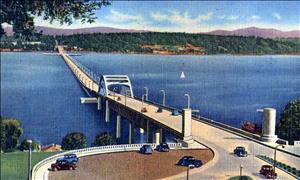On November 25, 1990, after a week of high winds and rain, the 50-year old Lacey V. Murrow Bridge (Lake Washington Floating Bridge) breaks apart and plunges into the mud beneath Lake Washington. Since it takes some time for the bridge to sag and finally crack apart, news cameras are poised and ready to show post-Thanksgiving TV viewers a once-in-a-lifetime telecast of the demise of the historic I-90 span. It is later discovered that hatchways into the concrete pontoon air pockets were left open, allowing water to enter, while the bridge was undergoing a $35.6 million renovation. A new Lacey V. Murrow Bridge will open the following summer.
The Biggest Thing Afloat
The floating bridge, designed by the engineer Homer Hadley (1885-1967), opened on July 2, 1940, to public acclaim and amazement. Many people thought that a concrete structure of this size (1.25 miles long) could never float, let alone handle traffic. At the time, The Seattle Times called it "the biggest thing afloat," easily larger than the ocean liner Queen Elizabeth, the giant of its day. On opening day, Governor Clarence Martin called the bridge "original, distinctive, striking and graceful -- a product of this great state's vision and constructive spirit."
The bridge, called the Lake Washington Floating Bridge or the Mercer Island Bridge, was in 1967 renamed the Lacey V. Murrow Memorial Bridge in honor of the state's highway director. It was a marvel of engineering. Planners originally expected the bridge to carry 2,000 people a day, but from the start more than 5,000 people used the bridge on a daily basis. When tolls were taken off the bridge in 1946, this number skyrocketed.
The bridge did more than carry traffic. It turned Mercer Island from a summer resort into a suburban community. The bridge also turned Bellevue from a collection of berry and chicken farms into the fourth largest city in the state.
Slow Motion Titanic
After 50 years of service, the bridge was in need of repairs. Starting in 1989, a twin span had been completed parallel to it to handle the tens of thousands of new commuters who now inhabited the burgeoning Eastside. Prior to the Thanksgiving holiday in 1990, workers for Traylor Bros., an Indiana-based construction firm hired to do the renovation, had cut six-foot-high holes into the hollow concrete pontoons to facilitate work. Unfortunately these holes had not been closed before the weekend of unusually high winds and rain.
On Saturday, pontoons in the center of the bridge were inspected and found to be dry, but when workers returned to the bridge on Sunday morning, they found them nearly submerged. Efforts were made to pump them out, but it was too late.
By this time, news organizations had gotten wind of the situation and, within a short time, helicopters hovered over the bridge. As viewers looked on, the bridge began to sag. By the afternoon, it began to break apart. One by one, sections of the bridge broke off. In Titanic fashion, the pieces upended themselves and then tilted, slicing their way to the bottom of the lake. By the end of the day, the bridge was gone.

